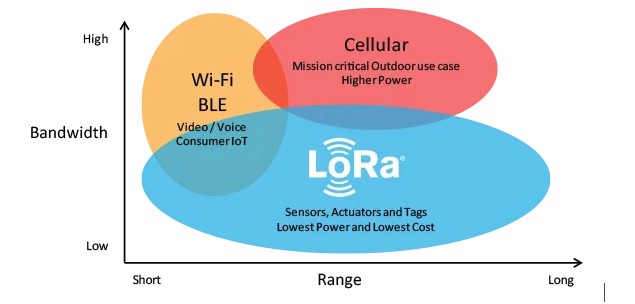

LoRa is a LPWAN communication technology, which is widely used in ultra-long-distance wireless transmission scenarios based on spread spectrum technology. Now, LoRa mainly works in free frequency bands such as 433, 868, and 915MHz around the world. Its biggest feature is high sensitivity, long transmission distance, low power consumption, and many network nodes.
We know that distance and power consumption are natural contradictions in communication systems. When the transmit power drops, the propagation distance must be close. So, how does LoRa solve this contradiction? The fundamental reason is that LoRa has a hyperlink budget, because LoRa can increase the sensitivity of the receiver and does not require high transmit power. The sensitivity of the LoRa receiver is based on the direct sequence spread spectrum technique. LoRa uses a high expansion factor for high signal gain. Typically, FSK requires 8dB of signal-to-noise ratio, while LoRa only requires -20dB.

The LoRa network is mainly composed of terminals (with built-in LoRa modules), gateways (or base stations), network services and application services. Application data can be transferred in both directions.
The LoRaWAN network architecture is a typical starting topology. In this network architecture, the LoRa gateway is a transparent transmission relay connecting end devices and back-end central services.
The terminal nodes of LoRa can be various devices such as water meters, gas meters, smoke alarms, pet tracking devices, etc. These ndes first connect to the LoRa gateway through LoRa wireless communication, and then connect to the network service through the 3G network. or Ethernet. The gateway and web server communicate via TCP/IP protocol.
The LoRa network divides terminal devices into three categories: A/B/C:
Class a: two-way communication terminal equipment
This type of terminal device allows two-way communication, and each terminal device has two downlink receive windows for its uplink transmission. The transmission time slot of the terminal device is fine-tuned based on the aroha protocol according to its own communication requirements.
Class b: Two-way communication terminal equipment with pre-set receive time slots
This type of terminal equipment opens redundant receive windows for a preset time. In order to achieve this, the terminal device receives the beacon synchronously from the gateway, and the time of the base station and the module is synchronized by the beacon.
Class C: Two-way communication terminal equipment with maximum receive window
End devices of this type will continue to open the receive window and only close during transmission.
Ebyte focuses on the Internet of Things wireless communication industry, always pays attention to the Internet of Things communication technology and industry development, and is at the forefront of the Internet of Things wireless communication technology. Maintain close cooperation with the above-mentioned chip manufacturers, and develop wireless communication modules that are easy to use, high quality and low price. Including WiFi module, Bluetooth module, Zigbee module, NB module, 4G module, private wireless module, LoRa module and LoRaWAN gateway module.







